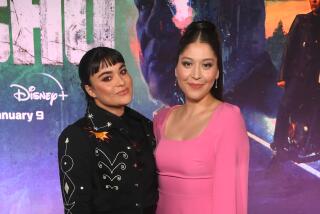East Indian Roles Are Caricatures
- Share via
Recently, a crew member on the set of a USC film asked me about my acting credits. When I listed them, he asked me how I felt about East Indians being caricatured in films and TV. I was pleasantly surprised that someone had noticed.
I don’t mind caricatures, so long as we also see East Indians of different professions, giving a balance that reflects reality. It’s not as if there aren’t enough of us to be noticed or written about as characters in American drama.
For example, where are the East Indian programmers or engineers represented in movies and television? Above all, where are the most common East Indians in American life--the doctors and nurses?
When I started acting in 1983, East Indian roles were limited to buffoons, whether they be janitors, cabdrivers or professors, except when an actor was playing the prime minister of India (which I did once on CBS in the series “Robert Kennedy and His Times”). When East Indians were not playing clowns, they were portrayed as cute.
I remember my role in “Mr. Belvedere” as a janitor who was invited to a family party. I had some line about doing my duties “nonviolently”--a poor attempt at humor a la Mahatma Gandhi.
Over the years, I have auditioned for parts that ranged from cabdriver to a 7-11 clerk to a janitor--the gamut from A to B. Nor are other East Indians faring better. How about the cabdriver on “Cosby”--isn’t he cute? Buffoonish, too? Nor do the occasional East Indian actors on “Seinfeld” (restaurant owners and such) fare much better.
Even if you argue that most of the characters of whatever ethnic heritage are clownish on sitcoms, there are still the more serious one-hour dramas that stereotype East Indians. “ER” and “Chicago Hope,” the two biggest medical shows, do not have an East Indian doctor ornurse. “St. Elsewhere,” now gone, had a recurring East Indian character, played by actor Kavi Raj, who was an anesthesiologist. Unfortunately, that character was used as comic relief, too.
Peter Sellers may have started this trend when he played (who else?) a buffoonish East Indian who couldn’t find a bathroom fast enough in the 1968 movie “The Party.” Sellers took the situation to its comic extreme, in the process creating an unforgettable character.
While there were some protests in India when “The Party” was released, at the time I thought the issue was blown out of proportion. But it seems most of today’s film and TV writers in the U.S. grew up with Sellers’ East Indian character in mind, and others just keep copying the myth. So when there was a push for diversity in films and TV, they went back to their memory chip, and there he was.
There have been some pleasant exceptions, including the coroner I played on “Murder One” and even the cabdriver I played on “NYPD Blue” because he was not a typical East Indian but an opinionated cabdriver who just happened to be East Indian.
Most East Indians are by nature passive, both politically and socially. We don’t have much clout in politics nor are we media-savvy. We remain in the background.
I and my friends have taken these buffoonish characters lightly and dismissed them as unimportant in the scheme of things. But it is time to say the obvious: Not all East Indians are clowns. Nor are they all store clerks or, if they are businessmen, do they only run motels or newspaper stalls, as some screenwriters seem to believe.
If script writers looked around, they would see East Indians working in all kinds of jobs and professions, especially in computer programming, teaching and medicine (some of the leading cardiologists in America are East Indian, as is the chief coroner of Los Angeles).
They need to open their eyes to the diversity around them and not take the easy way out by stereotyping people by ethnicity or race.
More to Read
Only good movies
Get the Indie Focus newsletter, Mark Olsen's weekly guide to the world of cinema.
You may occasionally receive promotional content from the Los Angeles Times.









